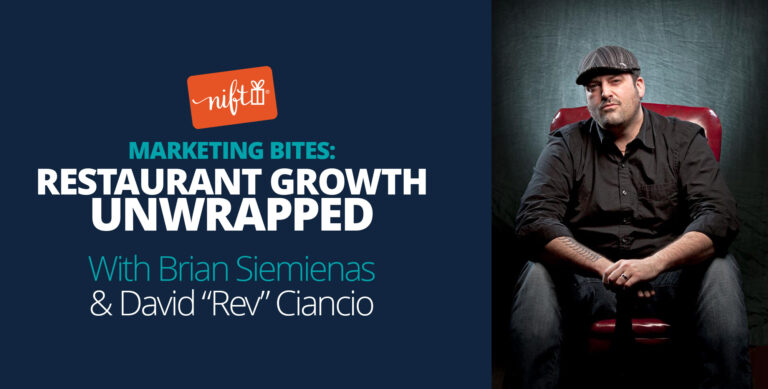Who’s ready to ride the roller coaster of marketing successfully in today’s restaurant world? With the insights from our latest podcast, you’re in for the thrill of your life.
Brian Siemienas sits down with David “Rev” Ciancio, the Co-Founder and Chief Marketing Officer of Handcraft Burgers and Brews. Whether you’re a food enthusiast, an aspiring restaurateur, or simply curious about the magic behind your favorite dining spots, this conversation is a must-listen! Here are some highlights from the episode:
- The state of the restaurant industry today
- Innovative approaches restaurants can use to drive foot traffic and leads
- Navigating rising marketing costs
- Why you need both CRM and loyalty programs (not one or the other)
- How to evaluate your technology stack
In this blog, we’ll cover the main points of Brian’s exciting conversation with Rev. Follow along and listen to the podcast here.
The World of Culinary Innovation
Culinary innovation is no longer optional—it’s essential. Restaurants that embrace new trends, menu creativity, and memorable dining experiences can differentiate themselves in an increasingly competitive landscape. But it’s not just what happens inside the restaurant that matters; with the rise of digital dining decisions, driving website traffic and converting visitors into loyal patrons is equally crucial.
The restaurant industry is much like a roller coaster—there are a lot of ups, downs, twists, and turns that can take you by surprise. Rev knows firsthand the many challenges restaurants face:
“There’s a lot of fear right now. January and February of this year were arguably the worst months on record in terms of my knowledge of the restaurant business and many of my colleagues. Too many restaurant group executives are reactively making decisions instead of proactively. Right now, it’s a race for any dollar.”
Organizations need to look at the most successful brands for inspiration to get out of the trenches. Consider McDonald’s. As one of the most successful restaurants on the planet, McDonalds is shifting towards bareball marketing, which is the art of balancing value and premium items. For example, if your restaurant offers a $4.99 meal deal or a half-off happy hour, consider what premium item you can also put out there that commands a higher dollar.
“Every restaurant is discount crazy right now. And that makes sense. You gotta spend money to make money, but further discounting doesn’t necessarily keep people interested. It’s on brand level appreciation.”
Navigating Rising Marketing Costs
Restaurant groups can’t seem to escape the rising costs of digital marketing, which is straining marketing efforts.
The rising costs of digital advertising, particularly on platforms like Google and Meta (Facebook), are squeezing marketing budgets. In addition, restaurants face other challenges like increased labor costs, higher ingredient prices, and a more demanding consumer base that expects personalized, seamless experiences. This means that even as marketing investments rise, the pressure to maximize every dollar also grows.
According to Rev, marketers must maintain the following mindset to succeed: What is the least amount of work for the highest return?
“It’s not lazy; it’s just being smart. It’s so much easier to send a well crafted, relevant email versus programming an expensive app. Five Guys is a perfect example. I go to Five Guys with my eight-year-old, and I love it, but I still don’t know why they have an app. Email would be so much easier for me.”
Revs top advice: Write everything down. Don’t rely on your memory for everything.
“Every marketer should be creating frameworks and playbooks. And no campaign should ever be launched without a goal. Write everything down—the goal, the campaign, the results, the moves you made, everything. Because if it works, you’re going to wanna do it again, and you’re going to improve on it and do it again. So write it down, man. Create frameworks, create playbooks, write checklists.”
Personalization Remains As Top Customer Demand
Marketing is a constantly moving target—algorithms update, digital marketing costs skyrocket, and consumer preferences change, but one thing that remains constant is the need for personalization.
One-size-fits-all marketing no longer works. Diners expect tailored experiences that resonate with their preferences and dining habits. Personalization in marketing allows restaurant groups to connect more deeply with their audiences, which can lead to higher conversion rates and increased customer loyalty.
CRM Versus Loyalty: Which is Better?
Many discussions in the restaurant marketing industry pin these two strategies against each other. But when restaurants desperately need to attract and retain new customers, why are we forcing customers into a funnel where they don’t want to go? CRM and loyalty aren’t one or the other. Instead, they should work together to build a solid and loyal customer database.
Rev stresses the importance of marketing to all your customers, not just some of them, so restaurant groups shouldn’t make decisions based on technology. Instead, marketing leaders need to make decisions based on guest behaviors.
Many guests in every restaurant’s database want to avoid being in an app or signing up for loyalty but are happy just to receive an email. It’s all about being frictionless. If you make your customers go through too many hoops to order a meal, they won’t come back. Rev ensures listeners that email marketing isn’t a dying art:
“The biggest opportunity for growth in restaurants is converting people from one-timers to two-timers. You’re not going to convert your entire organization of guests from one to two by forcing them to sign up for an app when they don’t know if they will eat here again. Email is such a massive opportunity for restaurant groups. Just capture somebody’s email address. The possibilities are endless once you have an email address.”
Today’s restaurant groups will drive more traffic through their doors using a powerful CRM tool paired with a customer-centric loyalty program.
Is Your Tech Stack Helping or Hurting Your Restaurant?
Like many small restaurant chains, yours probably doesn’t have an IT department the size of a small army. So, how do you evaluate if your tech stack is improving your operations or wasting your time? Rev says that restaurant decision-makers need to ask 6 key questions:
- Does this make me money?
- Does this save me money?
- Does this save me time?
- Does this make my employee’s job easier?
- Does this make the guest’s journey more manageable?
- Is the effort worth the reward?
If you answer yes to even three of those questions, it’s worth considering. But it’s not always so black and white.
“You could say yes to all those things, and then it only saved you a cent or only got you one new guest. It also made operations a bit easier, but it took you 84 hours to stand it up. At that point, it’s probably not worth it.”
The Magic of Burgers, Brews, And The Restaurant Industry Uncensored
Whether you’re savoring a juicy burger or dreaming of the perfect craft beer, this podcast episode offers a glimpse into the heart of the restaurant world. Tune in, learn, and get inspired! Discover more insights on marketing to today’s restaurant consumer, Rev’s latest restaurant adventures, and the advice he’d give his younger self. Listen here.
“As a marketer, to me, the golden performance metric is CRM growth, and that’s one of the things that I like about NIFT. The value of NIFT is to help me grow my CRM easily, scalable, and affordable. You can’t beat that.” – David “Rev” Ciancio.
If you’d like to learn more about how restaurant groups use Nift as a cost-effective, 100% trackable net-new customer acquisition channel to lower their CPA, hit ROAS targets, and grow their database with first-party data, request a demo with our team.
About the Author
Brian Siemienas is a seasoned marketing professional with over 25 years of experience in the restaurant, hospitality, and entertainment industries. As the Vice President of Restaurant Solutions at Nift, Brian is passionate about driving customer acquisition and enhancing restaurant traffic.
Before Nift, Brian’s tenure included leading marketing for brands like Darden, Margaritaville, and Hard Rock. Most recently, he was the CMO at IMCMV, overseeing 28 Margaritaville and Landshark Bar & Grill restaurants across the United States. Brian orchestrated a symphony of brand strategy, communications, partnerships, advertising, creative development, public relations, loyalty programs, and digital/social media in this role. Brian’s fingerprints are all over the success of these iconic establishments.
When Brian isn’t shaping marketing landscapes, he calls Orlando, FL, home. An avid theme park enthusiast, he explores local attractions, travels, and passionately follows college and NFL football. Brian holds a Bachelor’s Degree in Telecommunications and a Master’s in Mass Communications from the University of Florida.


